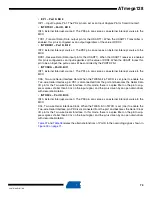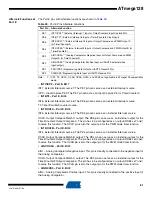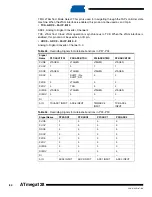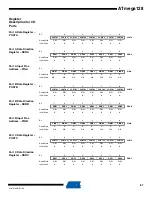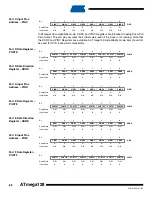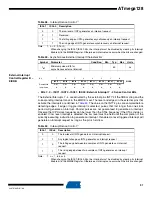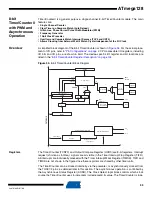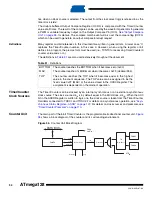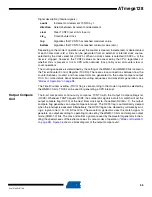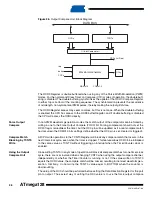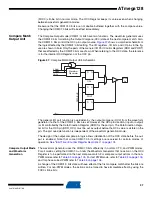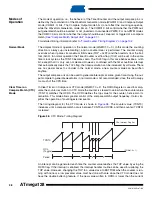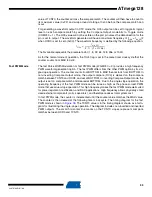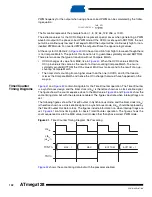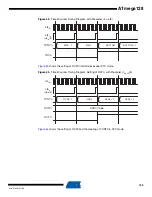
90
2467S–AVR–07/09
ATmega128
External
Interrupts
The External Interrupts are triggered by the INT7:0 pins. Observe that, if enabled, the interrupts
will trigger even if the INT7:0 pins are configured as outputs. This feature provides a way of gen-
erating a software interrupt. The External Interrupts can be triggered by a falling or rising edge or
a low level. This is set up as indicated in the specification for the External Interrupt Control Reg-
isters – EICRA (INT3:0) and EICRB (INT7:4). When the external interrupt is enabled and is
configured as level triggered, the interrupt will trigger as long as the pin is held low. Note that
recognition of falling or rising edge interrupts on INT7:4 requires the presence of an I/O clock,
described in
“Clock Systems and their Distribution” on page 36
. Low level interrupts and the
edge interrupt on INT3:0 are detected asynchronously. This implies that these interrupts can be
used for waking the part also from sleep modes other than Idle mode. The I/O clock is halted in
all sleep modes except Idle mode.
Note that if a level triggered interrupt is used for wake-up from Power-down mode, the changed
level must be held for some time to wake up the MCU. This makes the MCU less sensitive to
noise. The changed level is sampled twice by the Watchdog Oscillator clock. The period of the
Watchdog Oscillator is 1 µs (nominal) at 5.0V and 25
°
C. The frequency of the Watchdog Oscilla-
tor is voltage dependent as shown in the
“Electrical Characteristics” on page 318
. The MCU will
wake up if the input has the required level during this sampling or if it is held until the end of the
start-up time. The start-up time is defined by the SUT fuses as described in
their Distribution” on page 36
. If the level is sampled twice by the Watchdog Oscillator clock but
disappears before the end of the start-up time, the MCU will still wake up, but no interrupt will be
generated. The required level must be held long enough for the MCU to complete the wake up to
trigger the level interrupt.
External Interrupt
Control Register A –
EICRA
This Register can not be reached in ATmega103 compatibility mode, but the initial value defines
INT3:0 as low level interrupts, as in ATmega103.
• Bits 7..0 – ISC31, ISC30 – ISC00, ISC00: External Interrupt 3 - 0 Sense Control Bits
The External Interrupts 3 - 0 are activated by the external pins INT3:0 if the SREG I-flag and the
corresponding interrupt mask in the EIMSK is set. The level and edges on the external pins that
activate the interrupts are defined in
. Edges on INT3..INT0 are registered asynchro-
nously. Pulses on INT3:0 pins wider than the minimum pulse width given in
will
generate an interrupt. Shorter pulses are not guaranteed to generate an interrupt. If low level
interrupt is selected, the low level must be held until the completion of the currently executing
instruction to generate an interrupt. If enabled, a level triggered interrupt will generate an inter-
rupt request as long as the pin is held low. When changing the ISCn bit, an interrupt can occur.
Therefore, it is recommended to first disable INTn by clearing its Interrupt Enable bit in the
EIMSK Register. Then, the ISCn bit can be changed. Finally, the INTn interrupt flag should be
cleared by writing a logical one to its Interrupt Flag bit (INTFn) in the EIFR Register before the
interrupt is re-enabled.
Bit
7
6
5
4
3
2
1
0
ISC31
ISC30
ISC21
ISC20
ISC11
ISC10
ISC01
ISC00
EICRA
Read/Write
R/W
R/W
R/W
R/W
R/W
R/W
R/W
R/W
Initial Value
0
0
0
0
0
0
0
0




